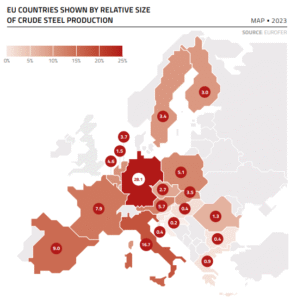The Nordic Near-Zero Emissions Steel project is a working example of industrial transformation.
Steel built the modern world: our cities, our infrastructure, our machines. Yet this foundational material is also responsible for nearly a tenth of global CO2 emissions. The steel industry faces an existential challenge: transform now or play catch-up in a complex and uncertain operational environment. More than a response to this challenge, the Nordic Near-Zero Emissions Steel project is a working example of industrial transformation.
Why the Nordics? A unique innovation frontier
The Nordic region stands at the global forefront of near-zero emissions steelmaking. This leadership stems from a powerful combination: cutting-edge energy systems, robust innovation ecosystems, strong existing steel industries, and the natural resources that support them. Finland and Sweden alone represent 6.4% of EU steel production in 2023, making the Nordic output the fifth largest in the EU.

Nordic-based companies like Stegra, SSAB, and Outokumpu are already making transformative investments: building the world’s first large-scale green steel plant, replacing polluting furnaces with electric arc technology, and pioneering pathways to zero-carbon metals. These projects prove that smaller regions can compete — and lead — globally.
A novel model for industrial transformation
Innovative actors in the field have been constrained by the very institutional apparatuses meant to represent them. Many mainstream forums and membership bodies tend to revert to conservative ambitions to secure consensus, a victim of the so-called “lowest common denominator” problem. Progressive companies, despite being ahead technologically, find their voices diluted in these entrenched structures.
This project is a bottom-up coalition of the willing. Rather than waiting for multilateral frameworks to catch up or for industry-wide consensus to emerge, the project assembles actors who have already decided to move. They are companies that have made the investments, taken the risks, and committed to the transition. This fundamentally changes the dynamic: instead of internationally or unintentionally delayed negotiation, coordination happens among those ready to accelerate.
Moreover, the project moves beyond the usual “partnership” or “alliance” model. It is built on cross-value chain coordination. Not just producers talking to producers, the entire ecosystem is aligned around shared goals. Besides the steelmakers, the conversation is joined by:
- construction companies which use steel in buildings (YIT),
- equipment manufacturers which need steel for machinery (Kalmar and Metso),
- energy companies which supply massive amounts of clean electricity (Fortum),
- engineering firms which design the new systems (AFRY),
- industry associations which understand the energy ecosystem (Finnish Energy),
- and crucially, policymakers and financiers whose decisions shape what’s possible.
By bringing these diverse actors together, the project creates something rare: a well-defined new structure where systemic transitions can be understood and addressed systemically. This cross-sectoral interaction increases the relevance of advocacy messages and offers a multidimensional way of thinking. Trade-offs can be negotiated transparently. Coordination failures can be identified and resolved. The sequencing of changes — what needs to happen when — can be mapped collaboratively rather than speculated independently. While traditional approaches silo these conversations, this project integrates them.
Perhaps most importantly, this represents a new form of environmental and economic cooperation when other forms stall. Top-down multilateral systems, such as COPs and global frameworks, struggle to deliver the pace of change we need. This project tests whether coalitions of willing actors, coordinated across borders and sectors, can move faster and more effectively.
How the project works: Three pillars of action
Funded by the TAH Foundation and European Climate Foundation, and coordinated by Demos Helsinki, Climate Leadership Coalition, and We Mean Business Coalition, this project brings together industry leaders, including Outokumpu, SSAB, Fortum, YIT, Kalmar, Stegra, Metso, AFRY, and Finnish Energy.
The project operates through three interconnected workstreams, each designed to address a different dimension of the transition challenge:
- Identifying barriers and opportunities for the steel transition. Understanding the key trends, drivers, and blockers determining the trajectory of the steel transition, alongside the risks and opportunities present for both the Nordics and Europe at large, and using that knowledge to guide actions.
- Coordinating policy positions across the steel value chain. Working with partners to create an aligned set of policy proposals to support and speed up the transition of the steel sector, enabling the entire value chain to act as a united front through a systemic approach.
- Conducting EU policy advocacy. Acting on behalf of the aligned coalition to engage European policymakers in Brussels, building awareness and support for the decarbonisation agenda.
Getting involved and learning more
Together through this project, we are demonstrating a new way forward:
- Bottom-up, cross-value-chain coalitions of the willing prove that ambitious climate action and industrial competitiveness go hand in hand.
- Private sector-led ambition and direction which seeks to show new policy options and shape markets, rather than passively waiting for circumstances to shift.
- Highlighting the essential role that well-designed regulation can play in supporting and scaling ambitious innovations which sit at the frontier of societal transformation.
If you are a company in the steel value chain genuinely committed to leading the transition, a policymaker working on industrial decarbonisation at national, Nordic, or EU level, a researcher studying industrial transformation and multi-stakeholder collaboration, or an actor from another sector or region facing similar challenges — let’s talk.
Feature image: Viktor Forgacs on Unsplash
